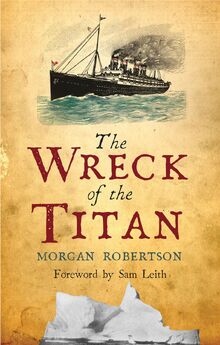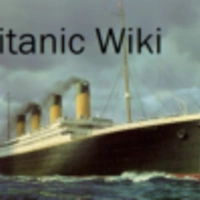
Futility, or the Wreck of the Titan is an 1898 novella written by Morgan Robertson. The story features the ocean liner Titan, which sinks in the North Atlantic after striking an iceberg. The Titan and its sinking have been noted to be very similar to the real-life passenger ship RMS Titanic, which sank fourteen years later. Following the discovery of the wreck, the novel was reissued with some changes, particularly in the ship's gross tonnage.[1]
Plot
The first half of Futility introduces the hero, John Rowland. Rowland is a disgraced former US Navy officer, who is now an alcoholic and has fallen to the lowest levels of society. Dismissed from the Navy, he is working as a deckhand on the Titan. On an April night the ship hits the iceberg, capsizing and sinking somewhat before the halfway point of the novel. The second half follows Rowland, as he saves the young daughter of a former lover by jumping onto the iceberg with her. After a number of adventures, in which he fights a polar bear (suffering permanent physical disability due to wounds sustained in the fight) and finds a lifeboat washed up on the iceberg, he is eventually rescued by a passing ship, overcomes his addiction and, over several years, works his way up to a lucrative Government job restoring his former income and position in society. In the closing lines of the story he receives a message from his former lover, pleading for him to visit her and her daughter.
Similarities to the Titanic
Although the novel was written before the RMS Titanic was even conceptualized and therefore there are about a dozen major differences between the two, there are some uncanny similarities between both the fictional and real-life versions. Like the Titanic, the fictional ship sank in April in the North Atlantic, and there were not enough lifeboats for the passengers. There are also similarities between the size (800 ft (244 m) long for Titan versus 882 ft 9 in (269 m) long for the Titanic[2]), speed (25 knots for Titan, 22.5 knots for Titanic[3]) and life-saving equipment.
Beyond the name, the similarities between the Titanic and the fictional Titan include:[4]
- Both were triple screw (propeller)
- Described as "unsinkable"
- The Titan was the largest craft afloat and the greatest of the works of men (800 feet, displacing 75,000 tons, up from 45,000 in the 1898 edition), and was deemed "practically unsinkable" (as quoted in Robertson's book).
- Shortage of lifeboats
- The Titanic carried only 16 lifeboats, plus 4 Engelhardt folding lifeboats,[5] less than half the number required for her passenger and crew capacity of 3000.
- The Titan carried "as few as the law allowed", 24 lifeboats, which could carry less than half of her total complement of 3000.
- Struck an iceberg
- Moving at 22½ knots,[6] the Titanic struck an iceberg on the starboard side on the night of April 14, 1912, in the North Atlantic, 400 nautical miles (740 km; 460 mi) away from Newfoundland.
- Moving at 25 knots, The Titan also struck an iceberg on the starboard side on an April night in the North Atlantic, 400 nautical miles (740 km; 460 mi) from Newfoundland (Terranova).
- Sinking
- The Titanic sank, and more than half of her 2200 passengers and crew died.
- The Titan also sank, and more than half of her 2500 passengers drowned.
Following the Titanic's sinking, some people credited Robertson with clairvoyance. Robertson denied this, claiming the similarities were explained by his extensive knowledge of shipbuilding and maritime trends.[7]
Popular culture
In audio plays
- The Doctor Who audio play The Wreck of the Titan, released by Big Finish Productions in May 2010, is partly inspired by this novella, and features the characters of John and Myra.
In games
- Akane Kurashiki (a.k.a. June), a character in the Nintendo DS game 999: Nine Hours, Nine Persons, Nine Doors, makes reference to the similarities between Titan and Titanic and cites this book as a potential example of trans-temporal communication in the game world.
- A copy of Futility can be seen in the apartment at the beginning of the PC game Titanic: Adventure Out of Time. The obituary of a Titanic passenger is used as a bookmark. In the game's Tour mode, the novel is mentioned by an NPC and the similarities between the Titan and the Titanic are mentioned.
In print
- There is a Space Liner in the Astroboy cartoons named Titan, which crashed on Earth's Moon.
- In his author's note of The Doomsday Box, Herbie Brennan mentions Futility's "prediction" to give examples of precognitive events.
- Walter Lord's nonfiction account of the Titanic disaster, A Night to Remember (1955), opens with a brief description of Robertson's novella and the similarities between the actual and fictional ships.
- The use of comparing the Titan and the Titanic was used for the 1956 dramatization for the Kraft
- Alan Moore's graphic novel The League of Extraordinary Gentlemen,[8] set in 1898, makes a passing reference to the Titan Relief Fund.
In television
- Similarities between the Titan and the Titanic were mentioned at the end of the episode Night of April 14 in the TV series One Step Beyond.[9] The host, John Newland, however, makes a number of errors in his comparison. He claims, for example, that the Titan, like the Titanic, sank on her maiden voyage. This is untrue.
- A dramatisation of what led the author to write it and detailing the similarities between the events in the book and the Titanic disaster were shown in an episode of Beyond Belief: Fact or Fiction.
| ||||||||||||||||||||||||||
References
- ↑ "The Titanic -Futility". http://historyonthenet.com/Titanic/futility.htm. Retrieved 2015-01-09.
- ↑ McCluskie, Tom (1998). Anatomy of the Titanic. PRC. p. 22. ISBN 1-85648-482-3.
- ↑ McCluskie, Anatomy of the Titanic, p. 23: Titanic's top speed was 21 knots, with a flank speed of 23.5 knots
- ↑ Robertson, Morgan (1898). Futility. New York: M. F. Mansfield.
- ↑ McCluskie, Anatomy of the Titanic, p. 120
- ↑ Mowbray, Jay Henry (1912). Sinking of the Titanic. Harrisburg, PA: The Minter Company. OCLC 9176732
- ↑ Hasan, Heba. "Author 'Predicts' Titanic Sinking, 14 Years Earlier". Time, April 14, 2012.
- ↑ The League of Extraordinary Gentlemen. Volume 1. Titan Books. ISBN 978-1-84023-302-5.
- ↑ http://video.google.com/videoplay?docid=9201023846486393680# Discussion of the book begins at 23:52 in the video
